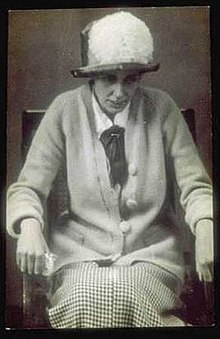Olive Wharry
Olive Wharry (born December 1886 in London , † October 2, 1947 in Torquay ) was an English painter and suffragette . She campaigned, sometimes with radical means, for women's rights .
Life
Olive Wharry was born as the daughter of Clara Vickers (1854-1910) and the doctor Oliver Robert Wharry (1853-1935) in London and grew up there. After her father retired, the family moved to Devon . Wharry studied at the School of Art in Exeter and in 1906 she went on major trips with her parents.
Wharry became interested in women's rights and became a member of the Church League for Women's Suffrage (CLWS) and the Women's Social and Political Union (WSPU).
Windows were broken in Parliament Square during a WSPU demonstration on November 22, 1911, in which Olive Wharry took part, and Wharry was one of 22 women sentenced to two months in Holloway Prison .
On March 4, 1912, she took part in a demonstration aimed at breaking windows in the government building in Whitehall. She was arrested and arrested along with 200 other suffragettes for participating in the demonstration. She was found guilty of breaking £ 195 worth of windows and was sentenced to six months in prison. Since the Holloway Prison was already full, she was transferred to the Winson Green Prison in Birmingham . She went on a hunger strike there and was released in July. According to the prison doctor, she was considered mentally unstable.
While in Winson Green Prison, Olive Wharry began working on a scrapbook recording the names of other inmates, writing limericks and poetry about other women, and making drawings of her cell and prison life. As Elizabeth Crawford noted in her book The Suffragette Movement (1999) , there is no evidence of mental instability in her records. The scrapbook is now in the possession of the British Library. While in custody, she met Constance Bryer , another suffragette with whom she remained lifelong friends.
When Christabel Pankhurst founded a group in July 1912 that wanted to fight more radically for women's rights, she joined this group. They carried out arson attacks in which empty buildings or churches were the targets. Wharry was involved in several arson attacks and was arrested along with Lilian Lenton on February 19, 1913 , shortly after they set fire to the tea pavilion in Kew Gardens. When she was arrested, she used the code name Joyce Locke . Shortly before their arrest, they were watched by police throwing bags away; in these were a hammer, a saw, a bundle that smelled strongly of paraffin and paper that smelled of tar. The other bag was empty, but it appeared to have contained flammable materials.
Her trial took place on March 7, 1913, and she was found guilty and sentenced to eighteen months in prison. She was released on April 8th after going on a hunger strike for 32 days. According to research by Elizabeth Crawford, apparently without the prison administration first noticing this. Olive Wharry hid the food she was given, and when she had to go to the prison doctor for a weigh-in, she would hide a filled hot water bottle under her clothes to add to her weight. As a result, she was not intended to be force-fed, although her health was considered to be compromised. After her release she returned to her father in Holsworthy , with whom she lived.
She was tried in Carnarvon in June 1914 after breaking windows in Criccieth . This action was preceded by a demonstration against David Lloyd George . Wharry was sentenced to three months in Halloway Prison under the pseudonym Phyllis North and was released into the care of Flora Murray on August 10 after a hunger strike .
England declared war on Germany on August 4, 1914. Just two days later, the National Union of Women's Suffrage Societies announced that they would suspend all political action until the war ended. The leadership of the Women's Social and Political Union also began to work with the government, and on August 10 the government announced that all suffragettes imprisoned would be released. Emmeline Pankhurst stated that she would cease her militant resistance and declare herself ready for military service.
After the end of the violent actions for women's rights, Olive Wharry continued her artistic career and in 1917 exhibited some works in an exhibition with works by other artists from Devon at the Royal Albert Memorial Museum . The Royal Albert Memorial Museum owns several of her works, including etchings and watercolors. She worked as a secretary for the Launceston and District Union Unionist Association.
Olive Wharry died in Torquay in 1947. She bequeathed her property and her Suffrage Medal to her friend Constance Bryer, along with some of her works. She bequeathed other works to other friends. As a last wish, she asked to be cremated and that her ashes should be distributed over the moor between Exeter and Whitstone.
literature
- Elizabeth Crawford: The Women's Suffrage Movement: A Reference Guide 1866–1928 . Routledge, 2003, ISBN 978-1-135-43402-1 , pp. 87 ( books.google.de ).
- Diane Atkinson: Rise Up Women !: The Remarkable Lives of the Suffragettes . Bloomsbury Publishing, 2018, ISBN 978-1-4088-4406-9 ( books.google.de ).
Individual evidence
- ↑ a b c d e f g Wharry, Miss Olive. In: org.uk. Retrieved February 24, 2019 (UK English).
- ↑ a b c d e f g Olive Wharry. In: spartacus-educational.com. Spartacus Educational, accessed February 24, 2019 .
Web links
| personal data | |
|---|---|
| SURNAME | Wharry, Olive |
| BRIEF DESCRIPTION | British suffragette |
| DATE OF BIRTH | December 1886 |
| PLACE OF BIRTH | London |
| DATE OF DEATH | October 2, 1947 |
| Place of death | Torquay |
